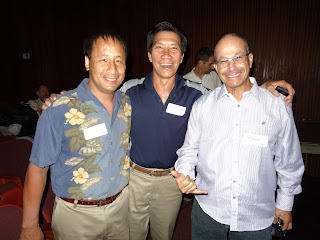 A week ago I posted on Death by a Gamma Ray Burst? This week, I focus on another space invader, a large asteroid. PBS has had several documentaries on this topic: The Asteroid and the Dinosaur and Dinosaur Apocalypse.
A week ago I posted on Death by a Gamma Ray Burst? This week, I focus on another space invader, a large asteroid. PBS has had several documentaries on this topic: The Asteroid and the Dinosaur and Dinosaur Apocalypse.The scientific term for the above is Impact Event. The biggest Earth event might have been the Big Splash, or the Theia Impact:
- This when our Moon was formed approximately 4.5 billion years ago.
- Theia, the mythical Greek Titan, was the colliding body, mother of Selene, the goddess of the Moon.
- The isotope ratios of lunar and terrestrial rock are identical.
- There are many theories, but one is that the Moon was formed by the tangential impact upon Earth of a body the size of Mars.
- Much of this giant-impact consensus emerged from a 1969 conference held at Kona, Hawaii. Those who don't believe are called the agnostics.
- 2 billion years ago an asteroid called Vredefort, from 12.4 to 15.5 miles across, struck South Africa, leaving a crater of 100 miles diameter. There was not much life on Earth then to cause any extinction problem. Time has eroded the crater, but this is something from NASA.
- Then that most famous of all impacts, the Chicxlub meteor, 6 to 9 miles across, hit the region near Mexican's Yucatan Peninsula, creating a crater of 112 miles diameter, killing off the dinosaurs. It is estimated that the energy released was 50,000 times more than the magnitude 9.1 earthquake that his Sumatra in 2004. Again, there is no impact evidence. Much of this remains speculation.
So should you be worried about menacing asteroids? Well, there appears to be no known threat for the next century, and the likelihood of a major impact in the next thousand years is exceedingly low. But if you die via asteroid, this is how it will happen. You can read that article.
Also in the West Pacific is Tropical Storm Haikui, who today weakened to 50 MPH, then strengthened to 60 MPH, and will reach hurricane strength tomorrow. The eye will head north of Zhejiang and should make landfall as a Category 1 hurricane on Sunday.
Just thought I'd show another ocean cyclonic storm heading for Hawaii, being thankful that it never attained hurricane strength, and should further weaken into a remnant low, bringing some rain. Now only at 40 MPH, Post-Tropical Cyclone Irwin seems headed on a path to take him north of the Hawaiian Islands.
-


















Comments
Post a Comment